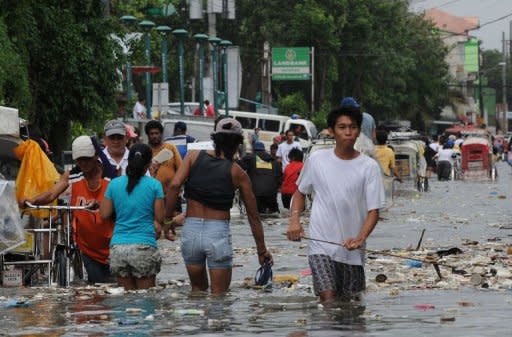Philippine floods persist, toll rises to 23
Rescuers deployed rubber boats while doctors fanned across cramped evacuation centres in the Philippines as the death toll from five days of flooding reached 23 on Thursday, officials said. Large farming towns north of the capital Manila as well as heavily populated coastal areas remained under waist deep floods, with television footage showing residents wading in muddy waters as they tried to seek safer shelters. Health officials meanwhile raised the alarm over a possible outbreak of leptospirosis, a bacterial disease spread by infected rat urine in flood waters, saying this could lead to a further spike in the death toll. "We are appealing for help from the national government. Our town hall itself is submerged in waist deep water," said mayor Orencio Gabriel of Obando town on government radio as intermittent rains continued to pound many areas. "We are all under water here," he said. Obando is a farming town of about 60,000 people 16 kilometres (10 miles) north of Manila where a major river system drains into Manila Bay. But high sea tides on Thursday morning worsened the flooding by slowing down the flow of water into the bay, even as Typhoon Saola had already began bringing its fury northward to Taiwan. "People are living in dire situations in evacuation centres and disease outbreaks are what could push the toll even higher," warned Carmencita Banatin, head of the department of health's emergency management unit. "We have rushed medicines and doctors to evacuation centres to begin immunising and stave off any explosion of diseases," she told AFP. The National Disaster Risk Reduction and Management Council in Manila said nine more people were killed due to drowning and other accidents related to Typhoon Saola, raising the toll to 23 overnight. Saola had caused tidal surges that swept over seawalls and flooded huge parts of Manila Wednesday, forcing schools to call off classes and flights to be grounded. Close to 180,000 people had been evacuated from 90 towns and 22 cities, many of them crowding each other in school gyms converted into temporary shelters. Banatin said said health workers were expecting an outbreak of leptospirosis which has an incubation of about a week. The worst outbreak of the disease occurred in Manila in 2009, when a major storm submerged more than 80 percent of the city of 15 million. Of the more than 3,300 cases of leptospirosis cases recorded then, 249 died, making it the biggest casualty figure for the disease in the world so far, according to government and World Health Organization figures.




